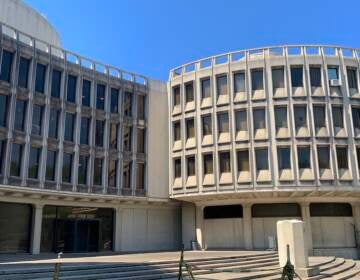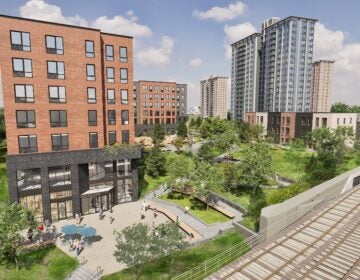‘It’s going to be hard’: Philly’s Roundhouse presents redevelopment challenge
A complicated history and challenging location face potential developers of the soon-to-be-empty Police Administration Building.

The ''Roundhouse,'' the Philadelphia Police Department's soon-to-be-former headquarters. (Steve Butler/WHYY)
Sometime next year, Philadelphia will solicit bids from real estate developers interested in acquiring the Roundhouse, a complicated piece of Philadelphia history located in a static corner of the city.
The response could be underwhelming. Property advisors and preservationists say the blocklong parcel at 7th and Race streets, which includes the former headquarters of the Philadelphia Police Department and a large parking lot, comes with a special set of challenges some developers may be loath to tackle.
“You’re going to need to find a courageous developer willing to build where really nobody else has been in decades,” said Trip Lukens, senior managing director of Valbridge Property Advisors.
The Roundhouse, the nickname for the soon-to-be-empty Police Administration Building, sits between Chinatown and Old City in a nebulous area dominated by institutional buildings and parking lots.
There’s a group of government properties, including the Federal Reserve Bank of Philadelphia, the Federal Detention Center, and the James A. Byrne U.S. Courthouse. The National Constitution Center, the American College of Physicians, and the soon-to-be relocated African American Museum in Philadelphia are also nearby.
The closest residential property is MetroClub, an eight-story condominium complex fashioned out of the former Metropolitan Hospital. Opened in 2005, the building is the most recent noteworthy development near the Roundhouse. It sits on an island across the street from the handcuff-esque building, close to on-ramps for I-676 and I-95.
“There’s just nothing that’s drawing people there,” said Lukens. “It’s just a sea of undeveloped ground around the property.”
The unusual shape and history of the Roundhouse could present further redevelopment challenges.
Completed in 1961 during a period known as urban renewal, the curvilinear building was considered a concrete marvel of sorts — here and across the country. It’s part of the reason why at least one group wants the city to put the building on the Philadelphia Register of Historic Places.
In subsequent decades, however, the Roundhouse became a source of pain for many residents. In the late 1980s and early 1990s, homicide detectives used coercion to obtain a number of false confessions. There are also documented cases of police holding witnesses for hours when there was no probable cause to support their detention inside the building.
The Roundhouse also has ties to the troubled rise of Frank Rizzo, who became the city’s police commissioner a few years after the Roundhouse opened. During his four-year tenure, the department became notorious for its use of violence, often against the city’s Black community.
That reputation continued through the 1970s while Rizzo was mayor, and still rings out today. In 2020, amid the racial justice protests sparked by the police murder of George Floyd, the city removed a larger-than-life statue of Rizzo from its post outside the Municipal Services Building in Center City.
To preservationist Maya Thomas, all of that must inform the Roundhouse’s redevelopment. Whether it’s demolished or left standing, Thomas said the site must have a social impact, even if it limits the pool of potential developers.
“It’s going to be difficult to find folks that want to build a museum or tackle police reform in their process of developing this building. So it’s going to be an interesting puzzle to put together. Not impossible, but it’s going to be hard,” said Thomas.
Asked to weigh in on the forthcoming RFP process, a city spokesperson exuded confidence in the redevelopment process.
“We believe that we’re starting in the right place with the Framing the Future process and that we’ll end up in the right place — with a realistic redevelopment project that meets the needs of the city and its residents,” said Bruce Bohri.
City officials say a months-long community engagement process, which began last week, will impact what ultimately happens to the Roundhouse, including how the city shapes its request for proposal to potential developers.
For now, the city says it’s open to preserving the Roundhouse for an adaptive reuse project, meaning it may face an additional layer of difficulty: disposing of a building with a far-from-standard design that can’t be demolished.
Architect Ian Smith, who sits on the board of the Preservation Alliance for Greater Philadelphia, said the requirement could make life more difficult for developers, but also produce a more valuable result that doesn’t “sanitize” the past.
If the Roundhouse is demolished, “it may not be something that people remember,” he said.

Subscribe to PlanPhilly
WHYY is your source for fact-based, in-depth journalism and information. As a nonprofit organization, we rely on financial support from readers like you. Please give today.









